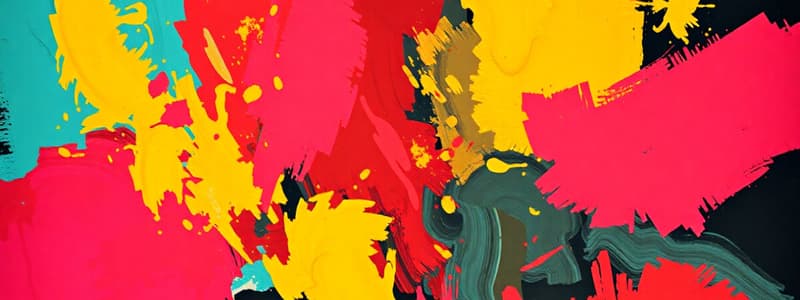Podcast
Questions and Answers
Which of the following techniques involves the use of a transparent support that captures an image without a negative?
Which of the following techniques involves the use of a transparent support that captures an image without a negative?
- Cyanotype
- Daguerreotype
- Photomechanical reproduction
- Ambrotype (correct)
What photographic process utilizes light-sensitive paper that develops an image through exposure to sunlight and a short chemical process?
What photographic process utilizes light-sensitive paper that develops an image through exposure to sunlight and a short chemical process?
- Salt print (correct)
- Gelatin silver print
- Gum printing
- Collodion (wet-plate)
Which method of printing involves the use of magnesium ash to create an image on a photosensitive surface?
Which method of printing involves the use of magnesium ash to create an image on a photosensitive surface?
- Heliography (correct)
- Pre-visualisation
- Camera lucida
- Pictorialism
Which of the following describes the photographic process that involves the use of a glass plate coated with a light-sensitive emulsion?
Which of the following describes the photographic process that involves the use of a glass plate coated with a light-sensitive emulsion?
What is the primary feature of the process termed 'Photogravure'?
What is the primary feature of the process termed 'Photogravure'?
Flashcards
Daguerreotype
Daguerreotype
A photographic process that captures an image directly onto a light-sensitive metal plate, creating a positive image.
Calotype
Calotype
A photographic process where a negative is produced on a paper surface, and then used to make a print.
Collodion (wet-plate)
Collodion (wet-plate)
A photographic process using a glass plate coated with a light-sensitive collodion solution, requiring processing while still wet.
Dry plate
Dry plate
Signup and view all the flashcards
Pictorialism
Pictorialism
Signup and view all the flashcards
Study Notes
Photographic Processes
- Pantograph: A process for creating copies of a drawing
- Physionotrace: A photographic process to record faces
- Silhouette: A process that produces a dark outline effect
- Camera lucida: A device allowing view of the image and the object simultaneously
- Camera obscura: A darkened box with a pinhole that creates an inverted image
- Sun printing: A process for creating images using sunlight
- Heliography: A process of making photographs using light
- Daguerreotype: An early photographic process using a silvered copper plate
- Calotype: An early silver-based photographic printing method
- Collodion (wet-plate): An older photographic process using wet plates
- Albumen paper: A type of paper used in an older photographic process
- Combination printing: A process involving negative/positive/direct positive steps
- 3-part laminar structure: A structure of photographs that creates a negative/positive process
- Latent image: A hidden image in the photographic material before development
- Tintype: A photographic process using a thin metal plate
- Ambrotype: A photographic process using glass for capturing images
- Cartes de visites: Small photographic cards
- Cyanotype: A photographic printing process using iron salts
- Stereoscopy/stereograph: A process involving two images to create a three-dimensional image
- Dry plate: A type of photographic plate that does not require wet processing
- Instantaneous photography: A fast photographic process
Photographic Techniques
- Snapshot: A quick photograph produced by a Kodak camera
- Kodak: A company known for its cameras and photographic advancements
- Magic lantern: An early device for projecting images
- Magnesium flash: A photographic flash using magnesium
- Pictorialism: A style of photography that emphasizes artistic expression
- Salt print: A photographic printing method using salt in the process
- Platinum print: A photographic printing method using platinum
- Gelatin silver print: A print made from gelatin silver halide
- POP (Printed out print): A type of print
- DOP (Developed out print): A printed copy from negative
- Baryta: A type of photographic paper
- Half-tone: A process for creating images in shades of gray from images
- Straight photography: A photographic style that focuses on accurately depicting the subject in the image
- Pre-visualisation: Creating a mental representation of the image to be captured
- Photogravure: A photographic technique for printing images
- Gum printing: A photographic printing process that involves gum (resin)
- Celluloid/nitrate film: A type photographic film
- Photomechanical reproduction: The process of creating multiple copies of an image
- Photo-magazine: A magazine that includes photographic images
- Autochrome: An early type of colour process in photography
- Kodachrome: An early colour photographic film
Studying That Suits You
Use AI to generate personalized quizzes and flashcards to suit your learning preferences.




